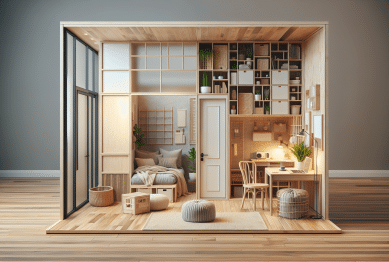Minimalist living is transforming homes and mindsets around the world. This guide explores practical approaches to decluttering, intentional habits, and how simplicity can improve overall happiness and wellness.
What Makes Minimalist Living Appealing
Minimalist living attracts people who crave clarity, freedom, and peace in a noisy world. By focusing on only the essentials, many find relief from clutter and unnecessary distractions. This approach encourages mindful decisions about what enters your home and how possessions influence daily routines. Minimalist practices aren’t just about owning fewer items; it’s about creating intentional spaces that support well-being, allowing individuals to feel lighter and less burdened by material goods.
The appeal also comes from minimalist living’s ability to foster more meaningful experiences. As clutter fades, new priorities surface—like connections, creativity, or calm. Research indicates that organized, simple environments are linked to reduced stress and improved focus, making every part of daily life more enjoyable. Many discover that simplifying leads to spending less time maintaining possessions and more time pursuing passions.
Adopting a minimalist mindset goes far beyond tidying up. It offers a framework for evaluating what truly matters, creating space for experiences rather than things. Minimalists find joy in small pleasures and experience contentment through gratitude and intentional living. The appeal lies in the flexibility: every person can define what minimalism means for their unique lifestyle, budget, and aspirations, ensuring the concept remains adaptable and personal.
How Decluttering Sets the Foundation
Decluttering is often the first step on a minimalist journey. It involves sorting through belongings, letting go of unused items, and making space for what serves a purpose or brings joy. This practice supports mental clarity and can even lessen feelings of anxiety often linked to crowded spaces. For many, decluttering is both a physical and emotional process, revealing how attachment to objects can sometimes stand in the way of growth.
The decluttering process encourages conscious consumption. Instead of buying impulsively, minimalists select items carefully, seeking quality over quantity. Choosing multipurpose or high-value objects fosters sustainability and financial health. Experts suggest starting small—perhaps a drawer or kitchen shelf—and building momentum over time. Consistent, manageable progress reduces overwhelm and sets the stage for bigger transformations.
Once clutter is gone, daily living often becomes more streamlined. It’s easier to locate belongings, clean, and stay organized. The benefits go beyond the tangible; many report feeling empowered and motivated by newly reclaimed spaces. Over time, the home becomes a sanctuary, supporting relaxation, creativity, and community gatherings. This foundational shift encourages further minimalist habits and contributes to greater life satisfaction.
Intentional Habits for Sustainable Minimalism
Sustainable minimalist living relies on habits that reinforce simplicity. One such habit is the “one in, one out” rule—bringing a new item into the home means parting with another. This practice keeps clutter in check and encourages mindful purchasing decisions. Other habits include periodic reviews of possessions, digital decluttering, and pausing before making new purchases to assess necessity.
Intentional routines extend into the digital world as well. Managing inboxes, reducing app clutter, and setting boundaries around screen time foster mental space and presence. Incorporating minimalist habits into daily routines, such as scheduled resets of common areas or practicing gratitude for existing items, helps sustain results. These practices create a feedback loop where the rewards of simplicity motivate ongoing commitment.
Many minimalists also embrace mindful consumption in food, activities, and schedules. Choosing quality nourishment, curating social calendars to focus on meaningful connections, and carving out restorative downtime become central. By evaluating how each commitment or possession aligns with core values, minimalist living becomes more than a style—it is a way of being. Routines refine and evolve, guided by continual reflection and personal growth.
Designing Spaces That Reflect Simplicity
Minimalist design principles focus on clean lines, neutral palettes, and functional layouts. Spaces feel open, inviting, and restful. The absence of excess decor draws attention to intentional statement pieces or natural light. Choosing materials that evoke calm—wood, linen, or glass—further enhances the sense of tranquility. The goal is not austerity but harmony; every element should serve a purpose or elevate mood.
Furnishings in minimalist homes are carefully selected for comfort, durability, and functionality. Flexible furniture, such as fold-out tables or modular seating, can adapt to changing needs. Storage solutions—like hidden cabinets or open shelving—keep essentials accessible yet unobtrusive. By designing spaces that anticipate daily habits, it’s easier to maintain order and enjoyment over time.
Minimalist design also extends outdoors, with patios, balconies, or gardens organized to maximize relaxation and connection with nature. Plants, sunlight, and fresh air uplift spirits and invite routine moments of pause. Houses do not need to be large to be minimalist; thoughtful arrangements and periodic reassessment help even small spaces feel expansive. The simplicity of home design often mirrors and reinforces internal calm and intentional living.
Minimalism’s Impact on Wellbeing and Relationships
There’s growing interest in understanding how minimalist choices impact mental and physical wellbeing. Evidence suggests that organized surroundings reduce cognitive load, allowing the mind to focus and process daily challenges more efficiently (https://www.ncbi.nlm.nih.gov/pmc/articles/PMC5579396/). Decluttered homes are linked to lower cortisol levels and improved emotional resilience, offering restorative havens amid modern busyness.
Relationships often benefit from minimalist living. Shared priorities around simplicity and experience build stronger bonds. Without distractions from excess, families communicate more openly and connect over favorite activities. Minimalism can also reduce arguments around cleaning, buying, or maintaining items, as clear guidelines make decision-making less stressful for everyone involved. This shared vision brings unity and peace to households seeking more time for each other.
Minimalist principles even extend to the broader community. By supporting local businesses, buying second-hand, or sharing tools with neighbors, people cultivate generosity and reduce waste. These choices foster connections beyond the home and can ripple out, promoting collective sustainability. Ultimately, the pursuit of less unlocks more time, space, and energy for compassion, creativity, and healthful living.
Overcoming Challenges and Myths About Minimalism
Adopting a minimalist lifestyle sometimes brings doubt or resistance. Common myths suggest minimalism is only for the wealthy or those living alone. The truth is, anyone can embrace the principles—regardless of family size, home type, or income. Minimalism is defined by intention, not austerity; it welcomes imperfection and evolving needs. Even gradual progress toward less can yield meaningful rewards.
Another misconception is the belief that minimalism means deprivation. However, the goal is enrichment—focusing resources and attention on what matters most. Overcoming the initial discomfort of letting go may involve revisiting the values that motivate change. Many use journaling, support groups, or professional guidance during big transitions, finding encouragement in the stories of others. Gentle, flexible approaches often lead to greater success and long-term benefits.
Over time, new challenges can arise—periods of busyness, shifting family needs, or lifestyle changes. It’s common to revisit habits and renew commitment to core values. Sustainable minimalist living is not static; it evolves with the person or household. By celebrating milestones and forgiving setbacks, individuals cultivate resilience, curiosity, and deeper fulfillment on their journey to simplicity.
References
1. Kondo, M. (2014). The Life-Changing Magic of Tidying Up. Retrieved from https://www.penguinrandomhouse.com/books/235784/the-life-changing-magic-of-tidying-up-by-marie-kondo/
2. American Psychological Association. (2019). The powerful impact of clutter on mental health. Retrieved from https://www.apa.org/monitor/2019/01/ce-corner-clutter
3. NIH. (2017). Declutter Your Life: How Less Stuff Can Lead to Less Stress. Retrieved from https://newsinhealth.nih.gov/2017/01/declutter-your-life
4. NCBI. (2017). Clutter, chaos, and the mind: psychological perspectives. Retrieved from https://www.ncbi.nlm.nih.gov/pmc/articles/PMC5579396/
5. Environmental Protection Agency (EPA). (2020). Tips for Sustainable Living. Retrieved from https://www.epa.gov/environmental-topics/greener-living
6. Mindful.org Editors. (n.d.). Minimalism and Mindfulness: Why Less Is More. Retrieved from https://www.mindful.org/minimalism-and-mindfulness/









